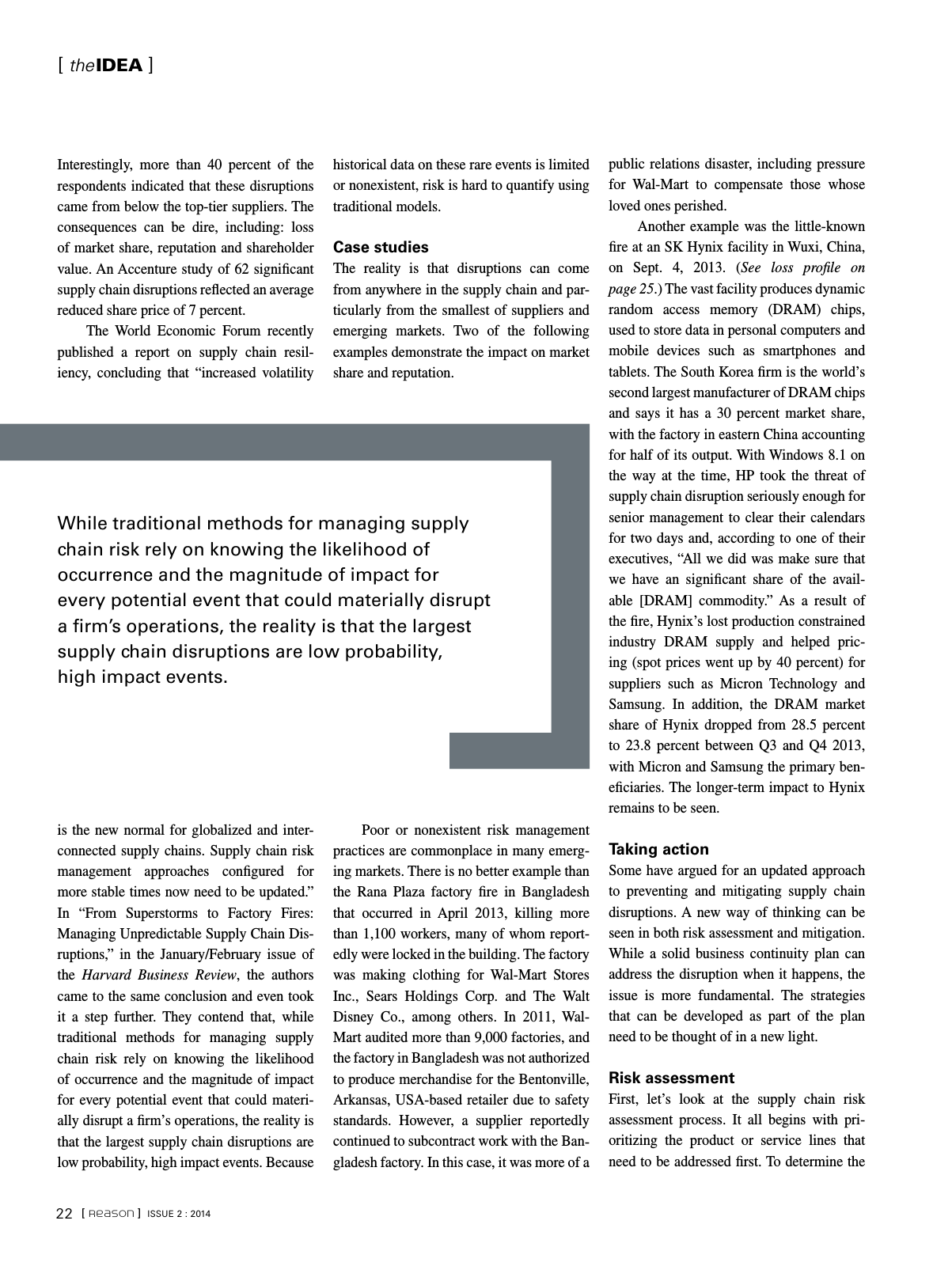Reason Magazine 2014 Quartal 2 Seite 22
Hinweis: Dies ist eine maschinenlesbare No-Flash Ansicht.Klicken Sie hier um zur Online-Version zu gelangen.
Inhalt
public relations disaster including pressure for Wal Mart to compensate those whose loved ones perished Another example was the little known fire at an SK Hynix facility in Wuxi China on Sept 4 2013 See loss profile on page 25 The vast facility produces dynamic random access memory DRAM chips used to store data in personal computers and mobile devices such as smartphones and tablets The South Korea firm is the world s second largest manufacturer of DRAM chips and says it has a 30 percent market share with the factory in eastern China accounting for half of its output With Windows 8 1 on the way at the time HP took the threat of supply chain disruption seriously enough for senior management to clear their calendars for two days and according to one of their executives All we did was make sure that we have an significant share of the avail able DRAM commodity As a result of the fire Hynix s lost production constrained industry DRAM supply and helped pric ing spot prices went up by 40 percent for suppliers such as Micron Technology and Samsung In addition the DRAM market share of Hynix dropped from 28 5 percent to 23 8 percent between Q3 and Q4 2013 with Micron and Samsung the primary ben eficiaries The longer term impact to Hynix remains to be seen Taking action Some have argued for an updated approach to preventing and mitigating supply chain disruptions A new way of thinking can be seen in both risk assessment and mitigation While a solid business continuity plan can address the disruption when it happens the issue is more fundamental The strategies that can be developed as part of the plan need to be thought of in a new light Risk assessment First let s look at the supply chain risk assessment process It all begins with pri oritizing the product or service lines that need to be addressed first To determine the Interestingly more than 40 percent of the respondents indicated that these disruptions came from below the top tier suppliers The consequences can be dire including loss of market share reputation and shareholder value An Accenture study of 62 significant supply chain disruptions reflected an average reduced share price of 7 percent The World Economic Forum recently published a report on supply chain resil iency concluding that increased volatility is the new normal for globalized and inter connected supply chains Supply chain risk management approaches configured for more stable times now need to be updated In From Superstorms to Factory Fires Managing Unpredictable Supply Chain Dis ruptions in the January February issue of the Harvard Business Review the authors came to the same conclusion and even took it a step further They contend that while traditional methods for managing supply chain risk rely on knowing the likelihood of occurrence and the magnitude of impact for every potential event that could materi ally disrupt a firm s operations the reality is that the largest supply chain disruptions are low probability high impact events Because historical data on these rare events is limited or nonexistent risk is hard to quantify using traditional models Case studies The reality is that disruptions can come from anywhere in the supply chain and par ticularly from the smallest of suppliers and emerging markets Two of the following examples demonstrate the impact on market share and reputation Poor or nonexistent risk management practices are commonplace in many emerg ing markets There is no better example than the Rana Plaza factory fire in Bangladesh that occurred in April 2013 killing more than 1 100 workers many of whom report edly were locked in the building The factory was making clothing for Wal Mart Stores Inc Sears Holdings Corp and The Walt Disney Co among others In 2011 Wal Mart audited more than 9 000 factories and the factory in Bangladesh was not authorized to produce merchandise for the Bentonville Arkansas USA based retailer due to safety standards However a supplier reportedly continued to subcontract work with the Ban gladesh factory In this case it was more of a While traditional methods for managing supply chain risk rely on knowing the likelihood of occurrence and the magnitude of impact for every potential event that could materially disrupt a firm s operations the reality is that the largest supply chain disruptions are low probability high impact events 22 Reason ISSUE 2 2014 the IDEA
